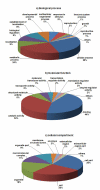Transcriptome analysis of the Cryptocaryon irritans tomont stage identifies potential genes for the detection and control of cryptocaryonosis
- PMID: 20113487
- PMCID: PMC2828411
- DOI: 10.1186/1471-2164-11-76
Transcriptome analysis of the Cryptocaryon irritans tomont stage identifies potential genes for the detection and control of cryptocaryonosis
Abstract
Background: Cryptocaryon irritans is a parasitic ciliate that causes cryptocaryonosis (white spot disease) in marine fish. Diagnosis of cryptocaryonosis often depends on the appearance of white spots on the surface of the fish, which are usually visible only during later stages of the disease. Identifying suitable biomarkers of this parasite would aid the development of diagnostic tools and control strategies for C. irritans. The C. irritans genome is virtually unexplored; therefore, we generated and analyzed expressed sequence tags (ESTs) of the parasite to identify genes that encode for surface proteins, excretory/secretory proteins and repeat-containing proteins.
Results: ESTs were generated from a cDNA library of C. irritans tomonts isolated from infected Asian sea bass, Lates calcarifer. Clustering of the 5356 ESTs produced 2659 unique transcripts (UTs) containing 1989 singletons and 670 consensi. BLAST analysis showed that 74% of the UTs had significant similarity (E-value < 10-5) to sequences that are currently available in the GenBank database, with more than 15% of the significant hits showing unknown function. Forty percent of the UTs had significant similarity to ciliates from the genera Tetrahymena and Paramecium. Comparative gene family analysis with related taxa showed that many protein families are conserved among the protozoans. Based on gene ontology annotation, functional groups were successfully assigned to 790 UTs. Genes encoding excretory/secretory proteins and membrane and membrane-associated proteins were identified because these proteins often function as antigens and are good antibody targets. A total of 481 UTs were classified as encoding membrane proteins, 54 were classified as encoding for membrane-bound proteins, and 155 were found to contain excretory/secretory protein-coding sequences. Amino acid repeat-containing proteins and GPI-anchored proteins were also identified as potential candidates for the development of diagnostic and control strategies for C. irritans.
Conclusions: We successfully discovered and examined a large portion of the previously unexplored C. irritans transcriptome and identified potential genes for the development and validation of diagnostic and control strategies for cryptocaryonosis.
Figures





Similar articles
-
Transcriptome analysis of dormant tomonts of the marine fish ectoparasitic ciliate Cryptocaryon irritans under low temperature.Parasit Vectors. 2016 May 13;9(1):280. doi: 10.1186/s13071-016-1550-1. Parasit Vectors. 2016. PMID: 27177617 Free PMC article.
-
Comparative transcriptional profile of the fish parasite Cryptocaryon irritans.Parasit Vectors. 2016 Dec 7;9(1):630. doi: 10.1186/s13071-016-1919-1. Parasit Vectors. 2016. PMID: 27923398 Free PMC article.
-
Transcriptome analysis of Cryptocaryon irritans tomont responding to Bacillus licheniformis treatment.Fish Shellfish Immunol. 2023 Sep;140:108943. doi: 10.1016/j.fsi.2023.108943. Epub 2023 Jul 12. Fish Shellfish Immunol. 2023. PMID: 37451523
-
Expression profile of immune-related genes in Lates calcarifer infected by Cryptocaryon irritans.Fish Shellfish Immunol. 2013 Mar;34(3):762-9. doi: 10.1016/j.fsi.2012.11.052. Epub 2013 Jan 4. Fish Shellfish Immunol. 2013. PMID: 23296118
-
Host responses against the fish parasitizing ciliate Cryptocaryon irritans.Parasite Immunol. 2023 Mar;45(3):e12967. doi: 10.1111/pim.12967. Epub 2023 Jan 27. Parasite Immunol. 2023. PMID: 36606416 Review.
Cited by
-
Transcriptome analysis of dormant tomonts of the marine fish ectoparasitic ciliate Cryptocaryon irritans under low temperature.Parasit Vectors. 2016 May 13;9(1):280. doi: 10.1186/s13071-016-1550-1. Parasit Vectors. 2016. PMID: 27177617 Free PMC article.
-
Comparative transcriptional profile of the fish parasite Cryptocaryon irritans.Parasit Vectors. 2016 Dec 7;9(1):630. doi: 10.1186/s13071-016-1919-1. Parasit Vectors. 2016. PMID: 27923398 Free PMC article.
-
Infectivity and genes differentially expressed between young and aging theront cells of the marine fish parasite Cryptocaryon irritans.PLoS One. 2020 Aug 28;15(8):e0238167. doi: 10.1371/journal.pone.0238167. eCollection 2020. PLoS One. 2020. PMID: 32857792 Free PMC article.
-
The Draft Genome of Cryptocaryon irritans Provides Preliminary Insights on the Phylogeny of Ciliates.Front Genet. 2022 Jan 12;12:808366. doi: 10.3389/fgene.2021.808366. eCollection 2021. Front Genet. 2022. PMID: 35096020 Free PMC article. No abstract available.
-
The effect of an adding histidine on biological activity and stability of Pc-pis from Pseudosciaena crocea.PLoS One. 2013 Dec 13;8(12):e83268. doi: 10.1371/journal.pone.0083268. eCollection 2013. PLoS One. 2013. PMID: 24349477 Free PMC article.
References
-
- Colorni A, Burgess P. Cryptocaryon irritans Brown 1951, the cause of 'white spot disease' in marine fish: an update. Aquar Sci Conserv. 1997;1(4):217–238. doi: 10.1023/A:1018360323287. - DOI
-
- Diggles BK, Lester RJG. Infections of Cryptocaryon irritans on wild fish from southeast Queensland, Australia. Dis Aquat Organ. 1996;25(3):159–167. doi: 10.3354/dao025159. - DOI
-
- Diamant A, Issar G, Colorni A, Paperna I. A pathogenic Cryptocaryon-like ciliate from the Mediterranean Sea. Bull Eur Assoc Fish Pathol. 1991;11(3):122–124.
-
- Colorni A. Aspects of the biology of Cryptocaryon irritans, and hyposalinity as a control measure in gilt-head sea bream Sparus aurata. Dis Aquat Organ. 1985;1:19–22. doi: 10.3354/dao001019. - DOI
Publication types
MeSH terms
Substances
LinkOut - more resources
Full Text Sources
Molecular Biology Databases
Research Materials

